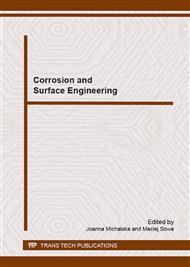p.43
p.47
p.51
p.55
p.59
p.63
p.67
p.71
p.75
Inhibition Effect of Guar Gum on the Corrosion Behaviour of Carbon Steel (K-55) in Fracturing Fluid
Abstract:
The inhibition effect of guar gum on carbon steel (K-55) in the simulated fracturing fluid under static conditions was studied. The electrochemical experimental results indicated that the carbon steel shows active dissolution behaviour in the absence and the presence of the inhibitor. However, guar gum, acting as mixed-type inhibitor, was swiftly able to promote the formation of a product layer onto the metal surface, lowering both cathodic and anodic current density. Electrochemical impedance spectroscopy (EIS) measurements were consistent with the polarisation curves, showing an improvement of the corrosion resistance of the carbon steel in the presence of the inhibitor. However, for long exposure times, the corrosion activity of the metal increases, as result of the breakdown of the corrosion product layer and initiation of localised corrosion spot. After both polarisation and EIS measurements, two different layers were observed. A thin, dark stable layer of magnetite and, for long holding times, a porous red layer, poorly adhered, of hematite. The hematite layer, due to its porous nature, was characterised by poor corrosion ability.
Info:
Periodical:
Pages:
59-62
Citation:
Online since:
January 2015
Authors:
Keywords:
Price:
Сopyright:
© 2015 Trans Tech Publications Ltd. All Rights Reserved
Share:
Citation:


